Ben Chifley
| The Right Honourable Ben Chifley | |
|---|---|
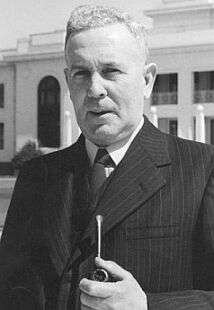 | |
| 16th Prime Minister of Australia Elections: 1946, 1949, 1951 | |
|
In office 13 July 1945 – 19 December 1949 | |
| Monarch | George VI |
| Governor-General |
The Duke of Gloucester Sir William McKell |
| Deputy |
Frank Forde H. V. Evatt |
| Preceded by | Frank Forde |
| Succeeded by | Robert Menzies |
| Leader of the Labor Party | |
|
In office 13 July 1945 – 13 June 1951 | |
| Deputy |
Frank Forde H. V. Evatt |
| Preceded by | John Curtin |
| Succeeded by | H. V. Evatt |
| Treasurer of Australia | |
|
In office 7 October 1941 – 18 December 1949 | |
| Prime Minister |
John Curtin Frank Forde Ben Chifley |
| Preceded by | Arthur Fadden |
| Succeeded by | Sir Arthur Fadden |
| Leader of the Opposition | |
|
In office 19 December 1949 – 13 June 1951 | |
| Prime Minister | Robert Menzies |
| Deputy | H. V. Evatt |
| Preceded by | Robert Menzies |
| Succeeded by | H. V. Evatt |
| Minister for Postwar Reconstruction | |
|
In office 22 December 1942 – 2 February 1945 | |
| Prime Minister | John Curtin |
| Preceded by | Office Created |
| Succeeded by | Office Abolished |
| Minister for Defence | |
|
In office 3 March 1931 – 6 January 1932 | |
| Prime Minister | James Scullin |
| Preceded by | John Daly |
| Succeeded by | George Pearce |
| Member of the Australian Parliament for Macquarie | |
|
In office 21 September 1940 – 13 June 1951 | |
| Preceded by | John Lawson |
| Succeeded by | Tony Luchetti |
|
In office 17 November 1928 – 19 December 1931 | |
| Preceded by | Arthur Manning |
| Succeeded by | John Lawson |
| Personal details | |
| Born |
22 September 1885 Bathurst, New South Wales, Australia |
| Died |
13 June 1951 (aged 65) Canberra, Australian Capital Territory, Australia |
| Political party | Labor |
| Spouse(s) | Elizabeth McKenzie |
| Profession | Politician, Engine driver and Trade unionist |
| Religion | Roman Catholic |
Joseph Benedict "Ben" Chifley (/ˈtʃɪfli/; 22 September 1885 – 13 June 1951) was an Australian politician who was the 16th Prime Minister of Australia from 1945 to 1949. He became Leader of the Labor Party on the death of John Curtin, and went on to retain a majority in both Houses of the Australian Parliament at the 1946 election, before his government was defeated at the 1949 election. The radical reforming nature of the Chifley Government was such that, between 1946 and 1949, the Australian Parliament passed 299 Acts, a record up until then, and well beyond the previous record of the Labor Government of Andrew Fisher, which passed 113 Acts from 1910 to 1913.[1]
Amongst the Chifley Labor Government's legislation was the post-war immigration scheme, the establishment of Australian citizenship, the Snowy Mountains Scheme, over-viewing the foundation of airlines Qantas and TAA, improvements in social services,[2] the creation of the Commonwealth Employment Service,[3] the introduction of federal funds to the States for public housing construction,[4] the establishment of a Universities Commission for the expansion of university education,[5] the introduction of a Pharmaceutical Benefits Scheme (PBS) and free hospital ward treatment,[3] the reorganisation and enlargement of the CSIRO, the establishment of a civilian rehabilitation service,[6] the founding of the Australian Security Intelligence Organisation (ASIO), and the establishment of the Australian National University.[7]
One of the few successful referendums to modify the Australian Constitution, the 1946 Social Services referendum, took place during Chifley's term.[8][9][10]
Early life
Born on 22 September 1885[11] in Bathurst, New South Wales,[8] Chifley was the son of a blacksmith of Irish Roman Catholic descent. Chifley was raised mostly by his grandfather for nine years. His grandfather had lost his savings in the bank crash of 1892/93, and Chifley acquired a lifelong dislike of private banks at an early age. He was educated at Roman Catholic schools in Bathurst and joined the New South Wales Railways at age 15. Chifley became an engine driver. He was one of the founders of the AFULE (the Australian Federated Union of Locomotive Enginemen)[12] and an active member of the Labor Party. In 1914 he married Elizabeth McKenzie, a staunch Presbyterian. The couple exchanged wedding vows in a Presbyterian church. Chifley remained a practising Catholic, but his marriage to a non-Catholic ignited criticism in certain Roman Catholic circles.[13] In 1917 he was one of the leaders of a prolonged strike, which resulted in his dismissal. He was reinstated by Jack Lang's New South Wales Labor government. Chifley represented his union before industrial tribunals and taught himself industrial law.
Parliament
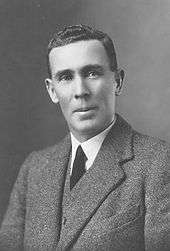
In 1928, at his second try, Chifley won the seat of Macquarie in the House of Representatives, which covered Bathurst, Lithgow, and the Blue Mountains. He was in general a supporter of the James Scullin government's economic policies, and in 1931 he became Minister for Defence. At the 1931 general election, the Scullin government was defeated in a landslide and Chifley lost his seat on a 16-point swing to the UAP's John Lawson. During the Depression he survived on his wife's family's money and his part-ownership of the Bathurst newspaper the National Advocate.
In 1935 the Lyons government appointed him a member of the Royal Commission on Banking, a subject on which he had become an expert. He submitted a minority report advocating that the private banks be nationalised.
After an unsuccessful effort to win back Macquarie in 1934, Chifley finally won his seat back in 1940 on a swing of 10 percent, and the following year he became Treasurer (finance minister) in John Curtin's Labor government. Although Frank Forde was nominally the number-two-man in the government, Chifley became the minister Curtin most relied on. He controlled most domestic policy while Curtin was preoccupied with the war effort. He presided over the massive increases in government expenditure and taxation that accompanied the war, and imposed a regime of economic regulation that made him very unpopular with business and the press.
Prime minister

When Curtin died in July 1945, Forde became Prime Minister for eight days. Chifley defeated him in the leadership ballot, replacing him as Prime Minister and Curtin as Labor leader. Once the war ended a month later, normal political life resumed, and Chifley faced Robert Menzies and his new Liberal Party in the 1946 election, which Chifley won with 54 percent of the two-party-preferred vote. It was the first time that a Labor government had been elected to a second full term. In the post-war years, Chifley maintained wartime economic controls, including the highly unpopular petrol rationing. He did this partly to help Britain in its postwar economic difficulties.
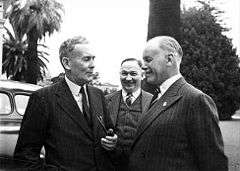
Legislative achievements
Feeling secure in power, Chifley decided it was time to advance towards Labor's objective of democratic socialism. According to a biographer of Chifley, his government embarked upon greater "general intervention and planning in economic and social affairs", with its policies directed towards better conditions in the workplace, full employment, and an improvement in the "equalisation of wealth, income and opportunity".[3] Chifley was successful in transforming the wartime economy into a peacetime economy, and undertook a number of social welfare initiatives,[14][15][16] as characterised by fairer pensions and unemployment and sickness benefits, the construction of new universities and technical colleges, and the building of 200,000 houses between 1945 and 1949.[17]
Among other measures, the Chifley government passed legislation to establish a universal public health system modeled on the British National Health Service, including a free formulary of essential medicines.[18] This was successfully opposed in the Australian High Court by the British Medical Association (precursor of the Australian Medical Association).[19] Chifley then organised one of the few successful constitutional referenda to insert a new section 51xxiiiA which permitted federal legislation over pharmaceutical benefits,[20] together with family allowances, benefits to students and hospital benefits, child endowment, widows' pensions, unemployment benefits, and maternity allowances.[21] The subsequent federal legislation in relation to pharmaceutical benefits was deemed constitutional by the High Court.[22] This paved the way for the Pharmaceutical Benefits Scheme,[23] an important component of Australia's modern public health system.
The 1946 referendum made possible many of the Chifley Labor government's other legislative initiatives in social welfare and social provision, including the following:
- in 1946, concessional rate radio licences were introduced for age and invalid pensioners. These concessions were later extended to widow pensioners and also to television licences;[24]
- in 1947, specific racial disqualifications other than those referring to Aboriginal Australians were removed, while the Wife's Allowance became payable to de facto wives who had lived with the pensioner for at least three years.[14] That same year, eligibility for a Class D pension was extended to women whose husbands were imprisoned for six months or more and were over 50 years old;[25]
- from July 1947, a prepayment of Maternity Allowance of five pounds could be made up to four weeks before the expected date of delivery, while the Act was amended to provide for an allowance of five pounds for each child in excess of one born from a single confinement (rather than there being separate rates for twins and so on). In addition, eligibility was extended to a mother who was an alien if she had 12 months residence;[26]
- in 1947, eligibility for Child's Allowance was extended to those wives whose husbands were in benevolent asylums and to single invalid pensioners of either sex who had the custody, care and control of a child aged under the age of 16. Additional Benefit of five shillings per week for the first child became available to a beneficiary making regular contributions of not less than five shillings towards the maintenance of such a child, in addition to the person having the control, care, and custody of the child).[27] Amendments were also made to legislation on Child Endowment to allow Australians temporarily absent from Australia and newly arrived migrants to receive the benefit;[28]
- from July 1947, funeral benefits could be paid in respect of claimants for Age Pension or Invalid Pension who would have qualified had they lived.[29] Under the Social Services Consolidation Act of 1947, an additional benefit became payable in cases where a man with one or more dependent children under the age of 16 had a housekeeper who was substantially dependent on him but not employed by him, where he was not receiving benefit for his wife; a partial additional benefit became payable for a partially dependent spouse; and wives legally separated or likely to be permanently living apart from their husbands became eligible for benefit;[30]
- the creation of the Commonwealth Employment Service,[3]
- the introduction of federal funds to the States for public housing construction,[4]
- the Acoustic Laboratories Act, passed in 1948,[31] established the Commonwealth Acoustic Laboratories to undertake scientific investigations into hearing and problems associated with noise as it affects individuals;[32]
- although it failed in its attempts to establish a national health service, the Chifley Government was successful in making arrangements with the states to upgrade the quality and availability of hospital treatment. The Mental Institutions Benefits Act (1948) paid the states a benefit equal to the charges upon the relatives of mental hospital patients, in return for free treatment. This legislation marked the entry of the Commonwealth into mental health funding.[33]
The achievements of both Chifley's government and those of the previous Curtin Government in expanding Australia's social welfare services (as characterised by a tenfold increase in commonwealth expenditure on social provision between 1941 and 1949)[34] were brought together under the Social Services Consolidation Act of 1947,[21] which consolidated the various social services benefits, liberalised some existing social security provisions, and increased the rates of various benefits.[6]
Among the government's other legislative achievements were:
- the establishment of a separate Australian citizenship in 1948;
- the Snowy Mountains Scheme[2] The aim was to reduce the country's reliance on coal-fired electricity. Militant mining unions had caused industrial upsets for decades previously. The infamous coal strike of 1949 was ended by Army intervention;
- nationalisation of Qantas in 1947 and establishment of TAA in 1946. Small at first these two model-of-efficiency airlines were later greatly expanded by conservative governments, who kept a tight quota on the number of airliners purchased;
- the reorganisation and enlargement of the CSIRO;
- the establishment of a civilian rehabilitation service;[6]
- the founding of the Australian Security Intelligence Organisation (ASIO);
- a Commonwealth Reconstruction Training Scheme was established to provide ex-servicemen with the opportunity to complete or undertake a university education. An interim five-year scholarship scheme was also established to encourage other able students to attend universities and annual grants to the universities to provide the staff and accommodation for the influx of assisted students and ex-servicemen.[35]
- tertiary education was also expanded through the establishment of the Australian National University and the Commonwealth Education Office.[10] The Australian National University Act was passed to provide post-graduate facilities in Australia and to augment the supply of staff for the universities.[7][35]
- returned soldiers were also provided with a war gratuity and entitlement to special unemployment allowances, loans, vocational training, and preference in employment for seven years. Soldier settlement schemes were better organized than their earlier equivalents, which had brought about a great deal of hardship throughout the Twenties and thirties;[36]
- the Rivers and Foreshores Improvement Act 1948 was passed with the intention of providing for "the carrying out of works for the removal of obstructions from and the improvement of rivers and foreshores and the prevention of erosion of lands by tidal and non-tidal waters";[37]
- the Dairy Industry Fund was established in July 1948 with the purpose of stabilising returns from exports;[38]
- in 1948, unmatched grants to the States were introduced to assist them in expanding their agricultural extension activities.[39]
- the establishment of a Coal Industry Tribunal and a Joint Coal Board (both in 1946) also brought significant gains for miners; and
- life insurance came to be comprehensively regulated.

The radical reforming nature of Chifley's government was such that between 1946 and 1949, the Australian Parliament enacted 299 bills, a record at that time.[21] Chifley and his ministers were able to ensure that Australia's wartime economy was managed effectively and that post-war debts were minimised. In addition, ex-service personnel were eased back into civilian life (avoiding the hardship and dislocation that had occurred after the end of the First World War), while a series of liberal measures were carried out which bore fruit during the economic boom of the Fifties and Sixties.[10] As noted by one historian, Chifley's government "balanced economic development and welfare support with restraint and regulation and provided the framework for Australia's post-war economic prosperity."[7]
Bank nationalisation and 1949 coal strike
In 1947, Chifley announced the government's intention to nationalise the banks. This provoked massive opposition from the press, and middle-class opinion turned against Labor. The High Court found Chifley's legislation to be unconstitutional. The government appealed the decision in the Privy Council, but it upheld the High Court's decision.
Chifley's government did, however, succeed in passing the Banking and Commonwealth Bank Acts of 1945, which gave the government control over monetary policy and established the Commonwealth Bank as Australia's national bank.[7]
A prolonged and bitter strike in the coal industry began in June 1949 and caused unemployment and hardship. Chifley saw the strike as a move by the Communist Party to challenge Labor's place as the party of the working class, and he sent in the army to break the strike. Despite this, Menzies exploited the rising Cold War hysteria to portray Labor as soft on Communism. These events, together with a perception that Chifley and Labor had grown increasingly arrogant in office, led to the Liberal election victory at the 1949 election. While Labor won an additional four seats in a House of Representatives that had been expanded from 74 seats to 121 seats, Menzies and the Coalition won an additional 48.
Opposition again
Chifley was now aged 64 and in poor health (like Curtin, he was a lifelong smoker), but he refused to retire from politics. Labor had retained control of the Senate, and Chifley, now Leader of the Opposition, took advantage of this to bring misery to the Menzies government at every turn.
Menzies responded by introducing a bill to ban the Communist Party of Australia in 1950. He expected Chifley to reject it and give him an excuse to call a double dissolution election. Menzies apparently hoped to repeat his "soft-on-Communism" theme to win a majority in both chambers. However, Chifley let the bill pass after a redraft (it was ultimately thrown out by the High Court). However, when Chifley rejected Menzies' Commonwealth Banking Bill a few months later, Menzies called a double dissolution election for April 1951. Although Chifley managed to lead Labor to a five-seat swing in the House, Labor lost six seats in the Senate, giving the Coalition control of both chambers.
Death
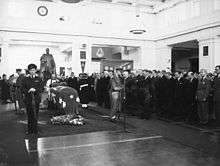
A few weeks later, Chifley suffered a heart attack in his room at the Hotel Kurrajong in Canberra (he had lived there throughout his political career, having refused to reside at The Lodge while Prime Minister).
Chifley at first made light of the sudden heart attack and attempted to dissuade his secretary and confidante, Phyllis Donnelly, who was making him a cup of tea, from calling a doctor. As his condition deteriorated, however, Donnelly called Dr. John Holt, who ordered Chifley's immediate removal to hospital. Chifley died in an ambulance on the way to the Canberra Community Hospital. He was pronounced dead at 10:45 pm.[40] Prime Minister Menzies heard of Chifley's demise while attending a parliamentary ball at King's Hall in Parliament House to celebrate the 50th Jubilee of Federation (Chifley was invited but had declined to attend). Menzies was deeply distressed and abandoned his normally impassive demeanour to announce in a halting subdued voice:
It is my very sorrowful duty during this celebration tonight to tell you that Mr. Chifley has died. I don't want to try to talk about him now because, although we were political opponents, he was a friend of mine and yours, and a fine Australian. You will all agree that in the circumstances the festivities should end. It doesn't matter about party politics on an occasion such as this. Oddly enough, in Parliament we get on very well. We sometimes find we have the warmest friendships among people whose politics are not ours. Mr Chifley served this country magnificently for years.[41]
Legacy
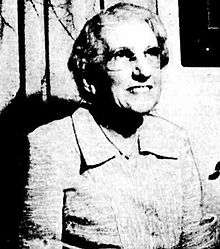
More than 30 years after his death, Chifley's name still aroused partisan passions. In 1987 the New South Wales Labor government decided to name the planned new university in Sydney's western suburbs Chifley University. When, in 1989, a new Liberal government renamed it the University of Western Sydney, controversy broke out. According to a debate on the topic, held in 1997 after the Labor Party had regained government, the decision to rename Chifley University reflected a desire to attach the name of Western Sydney to institutions of lasting significance, and that idea ultimately received the support of Bob Carr, later the Premier of New South Wales.[42]
Honours
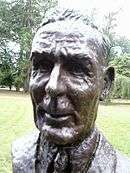
Places and institutions that have been named after Chifley include:
- the suburb of Chifley in Canberra
- the suburb of Chifley in Sydney
- the Division of Chifley, a federal electorate
- his former house in Bathurst, now the Chifley Home and Education Centre[43]
- Chifley Library, the main library of the Australian National University, Canberra
- Chifley Tower and Chifley Square in Sydney
- Chifley Cave (formerly the Left Imperial Cave), one of the Jenolan Caves in the Blue Mountains, New South Wales[44]
- several public high schools in Western Sydney are now known as Chifley College
- a grouping of dormitories at the Bathurst campus of Charles Sturt University are collectively named as Chifley Halls
- an Australian hotel chain.
In 1975 he was honoured on a postage stamp bearing his portrait issued by Australia Post.
One of the locomotives driven by Chifley, 5112, is preserved on a plinth at the eastern end of Bathurst Railway Station.
See also
- Chifley Government
- First Chifley Ministry
- Second Chifley Ministry
- 1949 Australian coal strike
- The light on the hill
References
- ↑ "Acts of the Commonwealth Parliament of Australia". ComLaw. Retrieved 28 August 2014.
- 1 2 Ghassemi, Fereidoun; White, Ian (2006). Inter-basin water transfer: case studies from Australia, United States, Canada, China, and India. Cambridge University Press. ISBN 9780521869690.
- 1 2 3 4 Lavelle, Ashley (2008). The death of social democracy: political consequences in the 21st century. Ashgate. ISBN 9780754670148.
- 1 2 Lyster, Rosemary; Lipman, Zada; Franklin, Nicola (2007). Environmental and planning law in New South Wales. Annanndale, N.S.W.: Federation Press. ISBN 9781862876309.
- ↑ "Ben Chifley". Prime Ministers of Australia. National Museum of Australia. Retrieved 4 November 2011.
- 1 2 3 Kewley, Thomas Henry (1965). Social security in Australia : the development of social security and health benefits from 1900 to the present. Sydney University Press. Retrieved 4 November 2011.
- 1 2 3 4 "Joseph Benedict Chifley, PC" (PDF). Australian Prime Ministers Centre, Museum of Australian Democracy. Retrieved 28 August 2014.
- 1 2 "The Rt Hon Ben Chifley". Australian Labor Party. Archived from the original on 31 August 2007. Retrieved 11 December 2007.
- ↑ "Significant Events in ASIO's History". Australian Security Intelligence Organisation. Retrieved 11 December 2007.
- 1 2 3 "Chifley, Joseph Benedict (1885–1951)". Australian Dictionary of Biography. Archived from the original on 4 July 2007. Retrieved 30 June 2007.
- ↑ "Fast Facts Ben Chifley". Retrieved 31 October 2014.
- ↑ "A.F.U.L.E. History". Australian Federated Union of Locomotive Enginemen. Archived from the original on 30 August 2007. Retrieved 3 September 2007.
- ↑ Duncan (2001), p. 163
- 1 2 Daniels, Dale (18 June 2004). "Social Security Payments for the Aged, People with Disabilities and Carers 1909 to 2003 – part 1". Parliament of Australia, Parliamentary Library. Archived from the original on 14 September 2004. Retrieved 15 August 2012.
- ↑ Daniels, Dale (8 November 2004). "Social Security Payments for the Unemployed, the Sick and those in Special Circumstances, 1942 to 2004". Parliament of Australia, Parliamentary Library. Archived from the original on 13 March 2005. Retrieved 15 August 2012.
- ↑ Daniels, Dale (5 July 2006). "Social Security Payments for People Caring for Children, 1912 to 2006". Parliament of Australia, Parliamentary Library. Archived from the original on 13 September 2006. Retrieved 15 August 2012.
- ↑ Swan, Wayne (19 September 2009). The light on the hill in the fog of global recession (Speech). Bathurst. Retrieved 29 August 2014.
- ↑ Sloan, Clyde (1995). A history of the Pharmaceutical Benefits Scheme, 1947–1992. Canberra: Department of Human Services and Health. p. 12. ISBN 0644334584.
- ↑ "Attorney-General (Vic); Ex rel Dale v Commonwealth". AustLII. 1945. Retrieved 28 August 2014.
- ↑ Day, David (2001). Chifley. Sydney: Harper Collins. pp. 443–444. ISBN 9780732267025.. It also authorised federal legislation over medical and dental services (but not so as to authorise any form of civil conscription)
- 1 2 3 "Social Services and Immigration". John Curtin Prime Ministerial Library. Retrieved 4 November 2011.
- ↑ "British Medical Association v Commonwealth [1949] HCA 44; (1949) 79 CLR 201 (7 October 1949)". AustLII. AustLII. Retrieved 29 August 2014.
- ↑ "National Health Act 1953". Commonwealth Consolidated Acts. AustLII. Retrieved 29 August 2014.
- ↑ Daniels, Dale (18 June 2004). "Social Security Payments for the Aged, People with Disabilities and Carers 1909 to 2003 – Pensioner Concessions from 1933". Parliament of Australia, Parliamentary Library. Archived from the original on 14 September 2004. Retrieved 29 August 2014.
- ↑ Daniels, Dale (8 November 2004). "Social Security Payments for the Unemployed, the Sick and those in Special Circumstances, 1942 to 2004". Parliament of Australia, Parliamentary Library. Archived from the original on 13 March 2005. Retrieved 1 September 2014.
- ↑ Daniels, Dale (15 October 2004). "Social Security Payments for People Caring for Children, 1912 to 2004: Maternity Allowance 1912 to 1978, and 1996 to 2004, Maternity Immunisation Allowance from 1998, Maternity Payment from 2004". Parliament of Australia, Parliamentary Library. Archived from the original on 13 March 2005. Retrieved 1 September 2014.
- ↑ Daniels, Dale (15 October 2004). "Social Security Payments for People Caring for Children, 1912 to 2004: Child's Allowance/Additional Pension or Benefit for Children 1943 to 1993". Parliament of Australia, Parliamentary Library. Archived from the original on 13 March 2005. Retrieved 1 September 2014.
- ↑ Daniels, Dale (15 October 2004). "Social Security Payments for People Caring for Children, 1912 to 2004: Child Endowment 1941 to 1976, Family Allowance 1976 to 1992, Basic Family Payment 1993 to 1995, Family Payment 1996 to 1998, Family Allowance 1998 to 2000 and Family Tax Benefit Part A from 2000". Parliament of Australia, Parliamentary Library. Archived from the original on 13 March 2005. Retrieved 1 September 2014.
- ↑ Daniels, Dale (18 June 2004). "Social Security Payments for the Aged, People with Disabilities and Carers 1909 to 2003: Concessions and Allowances". Parliament of Australia, Parliamentary Library. Archived from the original on 14 September 2004. Retrieved 1 September 2014.
- ↑ "A compendium of legislative changes in social security 1908–1982" (PDF). Australian Government Department of Families, Community Services and Indigenous Affairs. 1983. Occasional Paper No. 12. Retrieved 1 September 2014.
- ↑ "Ben Chifley, 1949". Australian Federal Election Speeches. Museum of Australian Democracy at Old Parliament House. Retrieved 1 September 2014.
- ↑ O'Neill, J.P. (1974). Official Year Book of Australia: No. 59, 1973. Australian Bureau of Statistics. p. 438. Retrieved 1 September 2014.
- ↑ "WWII Labor Government, 1941–1949, A Nationalised Health System?". History of Medicine. Australian Academy of Medicine and Surgery. Retrieved 4 November 2011.
- ↑ Thane, Pat (1982). Foundations of the welfare state. Longman. ISBN 978-0-582-29515-5.
- 1 2 Whitlam, Gough (1985). The Whitlam government 1972–1975. Viking. ISBN 978-0-670-80287-6.
- ↑ McMullin, Ross (1991). The light on the hill: the Australian Labor Party, 1891–1991. Oxford University Press. ISBN 978-0-19-554966-9.
- ↑ "Rivers and Foreshores Improvement Act 1948". New South Wales Repealed Acts. AustLII. 1948. Retrieved 1 September 2014.
- ↑ O'Neill, J.P. (1974). Official Year Book of Australia: no. 59, 1973. Australian Bureau of Statistics. p. 827. Retrieved 1 September 2014.
- ↑ O'Neill, J.P. (1971). Official Year Book of the Commonwealth of Australia: No. 57, 1971. Commonwealth Bureau of Census and Statistics. p. 746. Retrieved 1 September 2014.
- ↑ "Mr. Chifley Dies Suddenly After Seizure". The Mercury (Hobart, Tas. : 1860 – 1954). Hobart, Tas.: National Library of Australia. 14 June 1951. p. 1. Retrieved 1 September 2014.
- ↑ "Sudden Death in Canberra of Mr. J. B. Chifley". The Canberra Times (ACT : 1926 – 1995). ACT: National Library of Australia. 14 June 1951. p. 1. Retrieved 1 September 2014.
- ↑ "University of Western Sydney Bill – Second Reading". Parliament of New South Wales. 19 November 1997. Retrieved 18 April 2010.
- ↑ "Chifley Home & Education Centre". chifleyhome.org.au. Retrieved 24 October 2014.
- ↑ "Chifley Tribute". Sunday Times (Perth, WA : 1902 – 1954) (Country ed.). Perth, WA: National Library of Australia. 6 April 1952. p. 24. Retrieved 15 March 2013.
Bibliography
- Duncan, Bruce, Crusade or conspiracy?: Catholics and the anti-communist struggle in Australia, UNSW Press, 2001, ISBN 0-86840-731-3
Further reading
- Chifley, Ben (1952), Things Worth Fighting For (collected speeches), Melbourne University Press, Parkville, Victoria.
- Crisp, L.F. (1961), Ben Chifley: A Political Biography, Longman, Green and Co, Melbourne, Victoria.
- Day, David (2001), Chifley, HarperCollins, 2001
- Hughes, Colin A (1976), Mr Prime Minister. Australian Prime Ministers 1901–1972, Oxford University Press, Melbourne, Victoria, Ch.17. ISBN 0-19-550471-2
- Makin, Norman (1961), Federal Labour Leaders, Union Printing, Sydney, New South Wales, Pages 122–131.
- Waterson, Duncan (1993), Australian Dictionary of Biography Vol. 13 A-D pp. 412–420, Melbourne University Press, Carlton, Victoria.
External links
| Wikimedia Commons has media related to Ben Chifley. |
- "Ben Chifley". Australia's Prime Ministers. National Archives of Australia. Archived from the original on 5 July 2010. Retrieved 29 June 2010.
Waterson, D.B. (1993). "Chifley, Joseph Benedict (1885–1951)". Australian Dictionary of Biography. Canberra: Australian National University. Retrieved 29 June 2010.
- "Ben Chifley". National Museum of Australia. Retrieved 29 June 2010.
- Chifley Research Centre
- Chifley College, Sydney
- National Museum of Australia Chifley memorabilia: Ben Chifley's Akubra hat
| Political offices | ||
|---|---|---|
| Preceded by John Daly |
Minister for Defence 1931–1932 |
Succeeded by George Pearce |
| Preceded by Sir Arthur Fadden |
Treasurer of Australia 1941–1949 |
Succeeded by Sir Arthur Fadden |
| Preceded by Frank Forde |
Prime Minister of Australia 1945–1949 |
Succeeded by Robert Menzies |
| Preceded by Robert Menzies |
Leader of the Opposition 1949–1951 |
Succeeded by H.V. Evatt |
| Parliament of Australia | ||
| Preceded by Arthur Manning |
Member for Macquarie 1928–1931 |
Succeeded by John Lawson |
| Preceded by John Lawson |
Member for Macquarie 1940–1951 |
Succeeded by Tony Luchetti |
| Party political offices | ||
| Preceded by John Curtin |
Leader of the Australian Labor Party 1945–1951 |
Succeeded by H.V. Evatt |